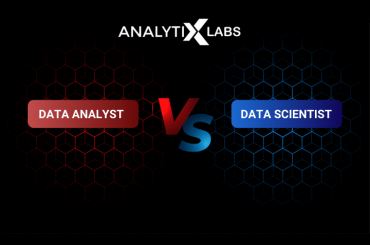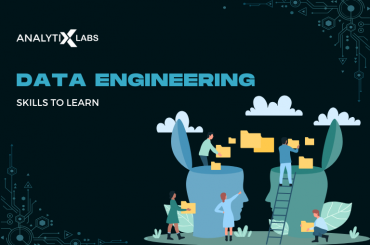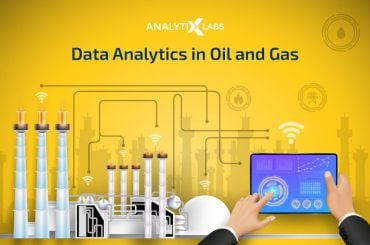Predictive analytics is a crucial component of data science. It is through predictive analytics that data scientists can predict future events and outcomes. The greater the volume of data available, the more precise your ability to accurately forecast future results will be.
A data-driven methodology, Predictive analytics leverages machine learning techniques and statistical algorithms to predict future outputs based on historical and current data patterns. Organizations can identify trends, patterns, and correlations by analyzing vast datasets, empowering them to make informed decisions and mitigate risks.
The market size of Predictive Analytics is expected to reach US$ 38,038 million by 2028.
Today, all types of businesses, governmental organizations, and investors rely on predictive data analytics for ‘future-proofing’ their activities, allowing them to make better decisions. This article will give you an in-depth knowledge of the definition of predictive analytics, its advantages, uses, tools, techniques, examples, etc.
Download the Data Science Bible – The Ultimate Guide to Becoming a Data Scientist
What is Predictive Analytics?
In the realm of business, predictive analytics is the visionary force that transforms uncertainties into strategic advantages.
Predictive Analytics is considered a sub-branch of advanced analytics in data science. Statistics and Mathematics are heavily involved in the various operations performed under predictive data analytics. To better understand predictive analytics, you first need to understand that analytics is done in multiple modes.
Understanding the 5 Types of Analytics
There are, by and large, five modes of data analytics. These are as follows-
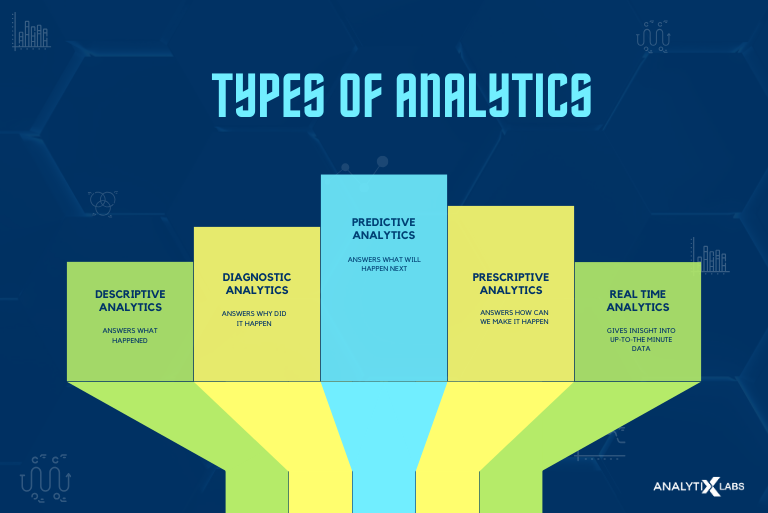
1) Descriptive analytics
Descriptive analytics is a common type of analytics. This type of analytics identifies what has happened for a business.
In descriptive analytics, various statistical methods are used to describe the data to understand the current status of a business/organization.
For example, if you were to describe a cube, you would measure its length, breadth, and height. Similarly, to describe data, one needs to ‘measure’ the data.
Here, like the length, breadth, and height of a cube, various measures of descriptive statistics come into play, such as
- The measure of Central Tendency (mean, median, mode)
- The measure of Variability (range, variance, standard deviation)
- The measure of Shape (symmetric, asymmetrical, type of distribution)
Descriptive analytics is performed in exploratory data analytics (the first and most common step when dealing with data).
2) Diagnostic analytics
The next type of analytics is diagnostic analytics. It identifies why something has happened. Typical statistical procedures performed under diagnostics include correlations, hypothesis testing (inferential statistics), linear regression, and other data discovery and drill-down operations
Also read: Descriptive vs. Inferential Statistics: Similarities and Differences
3) Predictive analytics
As discussed earlier, predictive analytics answers the questions of what might happen in the future and when it will happen. question for the business. This article will review the tools and techniques for predictive analytics.
4) Prescriptive analytics
A common discussion in the data science circles is between predictive vs. prescriptive analytics. These types of analytics complement each other as prescriptive analytics answers what the next steps for a business should be based on the insights provided by predictive analytics.
For example, if, as per predictive analytics, the company sees a lower sales figure, then the solution to this problem is tried to be found under prescriptive analytics.
5) Real-time analytics
Lastly, another form of analytics is real-time analytics, where data is analyzed as it gets generated and collected.
This relatively new type of analytics involves large datasets (big data), cloud computing, data pipelines, data streaming, etc.
Standard tools include Apache Kafka, Apache Strom, Spark Streaming, Google Cloud Data Flow, etc.
All these types of analytics tend to answer the ‘what’, ‘why’, ‘when’, and ‘how’ questions for a business, and in this article on predictive analytics, we focus on the ‘when’ question.Related read: Data Analytics: Applications and Use in Different Sectors
How is Predictive Analytics Performed?
Before you understand why and how predictive analytics is used, let’s first understand a typical process followed when performing data analytics. The whole process has 6 steps as follows.
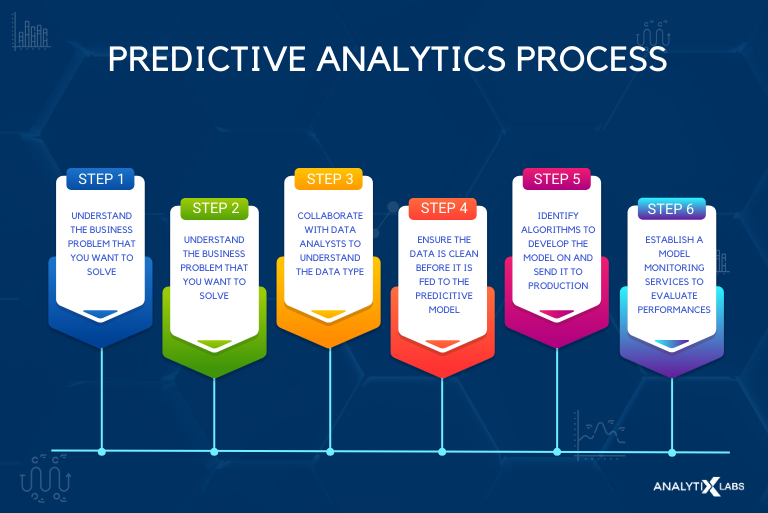
Step 1: Defining Business Problem
The first step is to have an understanding of the business problem that you intend to solve using predictive analytics.
Defining the business objectives includes identifying the stakeholders, understanding their issues, and the parameters on which the outcome of the predictive model will be evaluated. Good business acumen is required at this step.
Step 2: Defining Required Data
The next step is collaborating with data analysts and statisticians to understand the data type required for effective data analysis. Identification of datasets that can provide a complete picture of the situation is critical.
Accessing and combining data is crucial because the required data is often fragmented and located in multiple places.
The definition of the necessary data should encompass factors such as timeframe, level of aggregation, and various required inputs.
After this step, exploring and understanding the data is essential.
Step 3: Data Preparation
This step is often associated with data ‘cleaning’ and ‘exploration’. Predictive analytics, like many other data-based operations, follow the concept of GO-GA (Garbage In-Garbage Out).
Therefore, it’s important to have clean data before feeding it into a predictive model. Under this step, the typical tasks include cleaning data (missing value imputation, outlier capping), data transformation, feature reduction, etc.
Step 4: Predictive Modeling and Model Evaluation
The step most commonly associated with predictive analytics is the development of data models. Here, the data scientist identifies the most suitable algorithm based on the business problem and the available data’s nature, cleanliness, and quality.
The data is then fed into the model to develop predictions, which are evaluated to ensure the model performs decently.
Step 5: Model Deployment
Once the model is fully developed, the next step is to send it into ‘production’, where the operations team frequently uses the model developed by the data science team.
Data engineers here get involved so that the serving data required for the model can be accessed, stored, cleaned, and fed into the model at scale.
Also read: Data Scientists vs. Data Engineers: How the roles differ in data tasks
If possible, it is tried to automate the tasks performed using the output of the predictive model. Once the result is generated from the predictive model, it’s crucial to communicate the output with the stakeholders through reports, insights, actionable items, etc.
Step 6: Model Monitoring
Model degradation is a significant issue that teams face, given our dynamic world. Customer behavior, business climate, economic situation, etc., can change over time, significantly decreasing the model’s performance.
Therefore, companies need to establish model monitoring services where a model’s performance is constantly evaluated, and the model is taken out of production if considered degraded.
Now that you know the types of analytics and how predictive analytics is performed, let’s address the main question: Why is predictive analytics important?
Why is Predictive Analytics Important?
There are several reasons that companies consider predictive analytics crucial. Wholistically speaking, the primary reasons for implementing predictive analytics include:
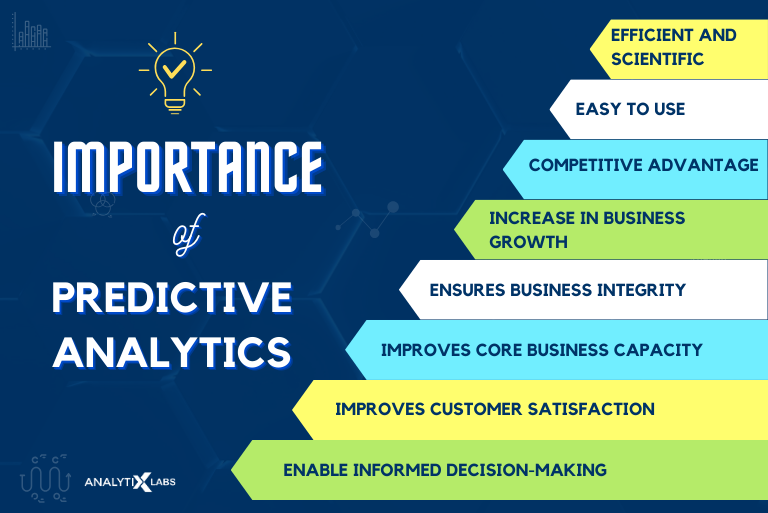
-
It is efficient and scientific
To estimate the future, one has to look at several aspects. Back in the day, this was either done by performing rigorous pattern detection operations on the historical data to develop rule-based programs, or decisions were made based on what the leadership felt would happen in the future based on their ‘experience’ and ‘gut feeling’.
While the former method was time-consuming, the latter was unscientific. Predictive analytics, on the other hand, is both fast and scientific. It uses statistics and mathematics to examine past data and predict the future in less time and with far more accuracy than earlier.
-
Predictive analytics is easy to use
Today, with advancements in tools and techniques, it’s far easier to estimate future events and make informed decisions than before. Predictive analytics is performed today by all sorts of people, from statisticians and mathematicians to business analysts and data scientists.
-
Helps businesses stay competitive
Predictive analytics allows businesses to stay competitive and ahead of other companies. As every company’s experience is unique, predictive analytics can tap into this experience and provide information that is unique to that particular company.
Unlike the broad trends that are readily available, predictive analytics allows the refinement of patterns at a micro level that can give highly crucial information.
Such information can include knowing where the competitors fall short, their weaknesses, and minute behavior trends encoded in the historical data that a company can exploit to stay ahead of its competitors.
-
Boosts business growth
Predictive analytics plays a crucial role in increasing growth. In consumer-facing activities, predictive analytics provides unique insights to companies where sales-related behavior (churn, clicks, responses, purchases, etc.) is used by predictive analytics to drive sales and marketing operations.
For example, by identifying those customers who are not likely to respond positively to your product/service, efforts are focused on interested ones, helping reduce costs and increase profit. Similarly, by quickly identifying churn customers, a business can take preventive measures to enable it to grow.
-
Ensures business integrity
Fraudulent activities are on the rise as the world goes global and digital. It’s crucial, therefore, for companies to safeguard their customer and identify criminal activities in time.
For example, a predictive model can determine if a transaction is fraudulent based on historical data. With increasingly sophisticated algorithms and abundant data, the false positives can be reduced, allowing for an accurate fraud detection system.
-
Improves core business capacity
Several times, predictive analytics directly improves a company’s core business. For example, a bank’s core business is to disburse loans and profit from the interest received. The worst enemy for a bank is a bad loan.
Predictive analytics can identify loan applications with a high probability of default, allowing banks to avoid such applications and minimize their NPAs.
-
Increases customer satisfaction
In almost all businesses, customer satisfaction is essential. Predictive analytics helps in increasing customer satisfaction in multiple ways.
For email, predictive analytics aids the customer by automatically moving junk mail into the spam folder. For e-commerce, predictive analytics help by recommending the right products to customers. Similarly, predictive analytics-based fraud detection can make customer transactions more secure for banks.
-
Enable informed decision making
As mentioned earlier, the leadership can make data-backed informed decisions through data and predictive analysis rather than relying on intuitions. This helps in reducing the chances of making wrong decisions that can cost a company dearly.
Also, in public companies, the leadership is accountable to the shareholders, and by making data-backed decisions, they can better justify their actions.
Now that we’ve understood the vital role of analytics in business success, starting with the learning process in this domain, it has become important.
Enroll in our Data Science and Analytics Courses for a complete learning experience that covers A-Z of data science and analytics. Choose your ideal course and transform your career with us.
- Data Science 360
- Business Analytics 360
- Data Visualization and Analytics
- PG in Data Science
- Post Grad in Data Analytics
Have more questions? Book a demo with us, and let us help you make the right choice.
Predictive analytics provides companies numerous opportunities to help them grow, stay competitive, increase their value, and make their customers happy. Let’s now look at some specific use cases of predictive analytics.
Predictive Analytics: Practical Applications
Multiple applications of predictive analytics help businesses solve their complex issues and discover lucrative opportunities. Common use cases of predictive analytics include the following-
Fraud Detection
As discussed earlier, fraud detection is a significant application area for predictive analytics. Today, predictive analytics helps identify fraudulent online and offline transactions for financial institutions. In addition, false insurance claims and identity thefts can also be reduced using predictive analytics.
Marketing Campaign Optimization
Predictive analytics helps businesses to detect accurate customer behavior and consumer behavior. This helps estimate their response to various marketing campaigns, helping businesses design effective campaigns. It reduces cost by reducing wasteful expenses, identifying the less effective marketing campaigns, and abandoning them in time
Customer Relationship Management (CRM)
CRM systems are crucial in sales, customer services, and marketing campaigns. Predictive analytics helps understand the customer life cycle, from the point of acquisition to their growth, retention, and eventual churn and win back. This allows business to retain their customers better and reduce churn.
Improvements in Business Operations
Data-based informed decision-making is made possible by predictive analytics. This allows the company to improve its operations and function more efficiently and effectively.
Cross Sell
Predictive analytics allows companies to understand better their customer’s behavior, including their likes and dislikes. Having this knowledge enables companies to sell additional products to their current customers. Cross-selling not only increases the revenue for a company but also helps retain customers.
Equipment Maintenance
Manufacturing, healthcare, and several other businesses have started to employ predictive analytics to schedule the maintenance of their equipment, which helps reduce costs and minimize accidental breakdowns (safeguarding human lives).
Today, integrating big data, IoT, and real-time predictive analytics enables companies to receive timely alerts in the event of a high likelihood of equipment breakdown.
Virtual Assistance
Siri, Alexa, and OK Google all utilize predictive analytics for functioning. All the chatbots you have interacted with are products of predictive analytics. Based on historical human interactions, models are trained to predict the correct response. Such chatbots and virtual assistants have allowed companies to manage customers better and provide them with support at a lower cost.
Content Recommendation
Businesses like e-commerce and video streaming platforms heavily rely on recommending the right products to their customers. Predictive analytics analyzes a customer’s past behavior and, based on it, recommends products they are more likely to interact with.
Underwriting
Many businesses depend on predicting the future of their customers to survive and be profitable. Predictive analytics, therefore, can help predict the probability of illness for insurance companies, default for banks, and bankruptcy for investment companies.
While there are many more application areas, such as risk minimization, dynamic pricing, supply chain analytics, etc., let’s look at some examples of predictive analytics by exploring a few domains and industries where predictive analytics benefits the business.
Applications of Predictive Analytics: Examples
There are various predictive analytics examples where it has proven beneficial and, in some cases, has fundamentally transformed the industry it was introduced to. The following are the most prominent examples of predictive analytics-
-
Retail
In the retail industry, predictive analytics has proven to be highly beneficial. For example, the demand for various products can be predicted based on region, seasons, and other factors. This helps the retailing industry identify the optimal inventory level to avoid overstocking or understocking.
-
Sports
The sports industry has increasingly used predictive analytics to assess and optimize players’ performance. The data collected in this industry is of two types – on-field and off-field. The on-field data refers to a player’s speed, time, health condition, tactics, etc. Such data is then used by the predictive models to estimate how well the player will perform in the future.
Off-field data refers to information about how well the sport is doing among the masses. Such data includes information about engagements, merchandise sales, and ticket sales collected from various sources, from ticket offices to social media. This data helps the management devise ways to keep the sports entertaining and relevant.
-
Healthcare
Of many examples of predictive analytics, healthcare is a prominent one. Today, hospitals and other healthcare institutions have developed mechanisms to collect patient data. The predictive models use this information about a patient’s conditions and health history to predict diseases, and epidemics, suggest treatment, the result of various treatments for a particular patient, etc.
-
Weather
Weather forecasting is a prime example of predictive analytics that you see daily. Predictive analytics considers historical meteorological observations and current information about the weather from satellites. It uses that data to predict not just tomorrow’s weather but also hurricanes, strong winds, heat waves, etc.
There are many domains where predictive analytics has proven beneficial. These include marketing, manufacturing, banking, finance, insurance, customer service, government & public sector, higher education, supply chain operations, oil & gas industry, human resources, social media analysis, Internet of Things (IoT), software testing, etc.
Therefore, predictive analytics plays a huge role in business. To completely understand predictive analytics, let’s now explore the various tools and techniques deployed when performing predictive analytics.
Top 6 Predictive Analytics Tools
Today, there are dedicated tools that perform predictive analytics for you. For a predictive data analyst to effectively perform their task, they need to use multiple tools. Each tool specializes in a particular aspect of predictive analytics, each with its pros and cons. If you go through the internet and explore predictive analytics articles, you will encounter that these common predictive analytics tools are in high demand.
1) IBM SPSS
IBM SPSS is a common commercial, government, and research tool. It allows for advanced predictive analytics backed by highly sophisticated statistics. The tool has two modules – SPPS Statistics and SPSS Modeller. SPSS Statistics provides tools and techniques for implementing various statistical tests such as hypothesis testing, geospatial analysis, etc.
In contrast, SPSS Modeller allows users to perform other data-related operations such as mining, text analysis, etc.
The primary advantages of this tool are its user-friendly nature, extensive statistical instruments, suitability for individuals without a programming background, and efficient handling of large datasets.
However, a significant drawback is its limited accessibility, given its subscription-based model and an outdated and slow interface.
2) SAS Advanced Analytics
The most common and early adopted predictive analytics tool is SAS. SAS is a commercial suite that allows for performing various predictive analytics-related tasks such as data mining, forecasting, optimization, statistical analytics, reporting, etc.
The most significant advantages of SAS include the numerous built-in modules that don’t require the writing of rigorous codes, a drag-and-drop display, and the fact that it can deal with large datasets. The biggest issue, however, with SAS is its cost.
Also read : How to learn SAS : Certification, Skills, and Opportunities
3) SAP Predictive Analytics & SAP Analytics Cloud
This tool is commonly used for performing predictive analyses in the commercial sector. The common features of SAP analytics include predictive forecasting, data exploration, visualization, financial planning, etc.
The advantages of SAP analytics include hassle-free installation, good visualization, easy data modeling, etc. The disadvantages are that it needs a stable internet connection for big data uploads and has poor latency.
4) H2O
Machine learning is a significant component of predictive analytics, and H20 provides various machine learning and AI algorithms, allowing users to create highly sophisticated and accurate predictive models.
While this open-source machine learning library excels in automation, seamless integration with big data, and application deployment, it faces challenges due to limited documentation and visualization capabilities.
5) Python
While it’s a general-purpose tool, many predictive data analysts rely on Python as it has several libraries that enable predictive analytics. These include libraries like Scikit-Learn, Pandas, Stats Models, Matplotlib, NLTK, Keras, Tensorflow, etc., that, when used together, can allow the user to complete all the steps in the predictive analytics lifecycle.
The advantage of using Python for predictive analytics is that it’s open source, free to use, competent, and has a big community. The disadvantage is that it’s difficult for those who lack programming skills.
6) R Studio (R Programming)
Like Python, R is an open-source, free-to-use programming language that allows users to perform predictive analytics. It differs from Python in that it is a statistical language developed by statisticians for statisticians.
R has several advantages, including its excellent interface (with R Studio considered among the best IDEs available), a vast collection of libraries capable of running highly sophisticated statistical tests and machine learning algorithms, and its ability to connect to servers.
Much like Python, a disadvantage of R is the requirement from the users to have a considerable amount of programming knowledge and is frequently considered to have a steeper learning curve than Python.
Also read: Benefits of Learning R Programming Language
You can enroll in our Data Science with Python and Data Science using R courses to start learning Python and R.
Have some more questions? Book a demo with us, and let’s choose your career.
The above list is not exhaustive, as many more tools are available to help you perform predictive analytics. Some of the prominent ones include-
- Oracle DataScience
- Q Research
- WebFOCUS By TIBCO
- RapidMiner Studio
- KNIME Analytics Platform
- Dataiku
- FICO Predictive Analytics
- Halo Software By Logility
- Altair Datawatch Knowledge
- Alteryx
- TIBCO Statistica
As you understand what tools are used in predictive analytics, let’s briefly explore the numerous techniques used for predictive analytics.
Techniques of Predictive Analytics
Several techniques are used when performing predictive data analysis. The common techniques include the following-
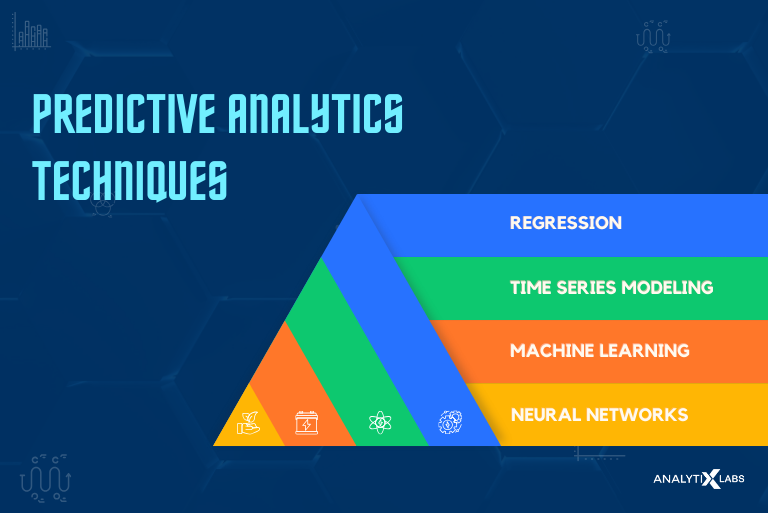
- Regression
Regression techniques allow the user to establish a linear relationship between the predicted and predictors. This statistical procedure is considered highly important, where you need a high level of interpretability. Common regression techniques include linear and logistic regression.
Also read: Regression Series:
- Time Series Modeling
Time Series modeling methods like Decompositions, ARIMA, ARCH, GARCH, etc., allow for predicting values over time by considering trends, seasonality, and cyclicity.
Also read: Time Series Analysis and Forecasting for data analysis and prediction
- Machine Learning (SVM, KNN, etc.)
Machine learning algorithms have transformed the world of predictive analytics. This technique enables data scientists to accurately predict events using a large amount of data without adhering strictly to the assumptions required by statistical algorithms.
Also read:
- Neural Networks
Predictive analytics has taken a giant leap by introducing neural networks to predictive models. Neural networks mimic the human brain cell neuron to solve highly complex problems without getting into the minute details of the problem.
Also read:
Other important techniques during predictive data analysis include-
- Decision Trees
- Test Analytics
- Bayesian Analysis
- Ensemble Models
- Cluster Models
Conclusion
Predictive business analytics is crucial as it allows companies to formulate informed decisions and better prepare them for future events. Today, all types of businesses use predictive analytics to mitigate risks, stay competitive, determine the likelihood of a product/service succeeding or failing before its launch, etc.
Predictive analytics also helps reduce wasteful capital expenditure by identifying ineffective marketing campaigns, workflow optimization issues, etc. However, there are several issues with predictive analytics, too, that you must keep in mind when using such a powerful technique.
When delving into articles on predictive analytics, a prevalent critique revolves around the duration needed to generate practical and actionable solutions. The extensive time invested in collecting and cleansing data to render it model-ready is the substantial initial investment for implementing predictive analytics operations within a company and the accompanying disruptions.
Despite these challenges, the benefits of predictive business analytics typically surpass the drawbacks for most companies. As a result, individuals engaged in data science should possess a comprehensive understanding of predictive analytics.
FAQs:
- What are the four steps in predictive analytics?
The four prominent steps in predictive analytics are-
- Defining the business problem and required data
- Data Preparation
- Predictive Modeling
- Model Deployment & Model Monitoring
- Where is predictive analysis used?
Businesses use it for risk management, fraud detection, operational optimization, forecasting, etc.
We hope this article helped you enhance your knowledge about predictive analysis and its related tools, techniques, use cases, etc. If you want to know more about data analytics or want to learn it, book a demo with us!


